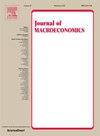Bilateral output synchronization in a globalized world: A macroeconomic evaluation of the third-country effect
IF 1.5
3区 经济学
Q3 ECONOMICS
引用次数: 0
Abstract
This paper examines the influence of third countries on the output synchronization between two trading partners. We first address this issue in a three-country Dynamic Stochastic General Equilibrium model, where trade in intermediate goods operates at the intensive and extensive margins. We find that adding a third trading partner strengthens the output co-movement between two countries through two channels: a trade channel, driven by a higher total number of varieties traded that makes production processes more homogeneous across countries, and a macroeconomic channel where the third country exerts a stabilizing effect on the intensive and extensive margins of production in the other two countries. Applying Jordà’s local projections to 34 countries from 1979Q2 to 2019Q4, we find that the inclusion of a third partner raises the output co-movement in 75% of cases on average, with a median rise of 54% on average compared to the two-country case. Our results are robust to (i) an alternative identification of productivity shocks and (ii) the inclusion of extensive trade margins as control variables. Those stylized facts of upward output synchronization resulting from the explicit inclusion of a third trading partner are consistent with our theoretical predictions.
全球化世界中的双边产出同步:第三国效应的宏观经济评价
本文考察了第三国对贸易伙伴间产出同步的影响。我们首先在一个三国动态随机一般均衡模型中解决了这个问题,其中中间产品的贸易在集约化和外延化的边际上运行。我们发现,增加第三个贸易伙伴通过两个渠道加强了两国之间的产出协同运动:一个是贸易渠道,由更高的交易品种总数驱动,使各国的生产过程更加同质化;另一个是宏观经济渠道,其中第三国对其他两国的集约和粗放生产边际发挥稳定作用。将jord的本地预测应用于1979年第二季度至2019年第四季度的34个国家,我们发现,在平均75%的情况下,第三个合作伙伴的加入提高了产出共同运动,与两个国家的情况相比,中位数平均增加了54%。我们的结果对于(i)生产率冲击的替代识别和(ii)广泛的贸易利润率作为控制变量的包含是稳健的。由于明确包含第三个贸易伙伴而导致的产出向上同步的程式化事实与我们的理论预测一致。
本文章由计算机程序翻译,如有差异,请以英文原文为准。
求助全文
约1分钟内获得全文
求助全文
来源期刊

Journal of Macroeconomics
ECONOMICS-
CiteScore
2.50
自引率
7.10%
发文量
53
审稿时长
76 days
期刊介绍:
Since its inception in 1979, the Journal of Macroeconomics has published theoretical and empirical articles that span the entire range of macroeconomics and monetary economics. More specifically, the editors encourage the submission of high quality papers that are concerned with the theoretical or empirical aspects of the following broadly defined topics: economic growth, economic fluctuations, the effects of monetary and fiscal policy, the political aspects of macroeconomics, exchange rate determination and other elements of open economy macroeconomics, the macroeconomics of income inequality, and macroeconomic forecasting.
 求助内容:
求助内容: 应助结果提醒方式:
应助结果提醒方式:


